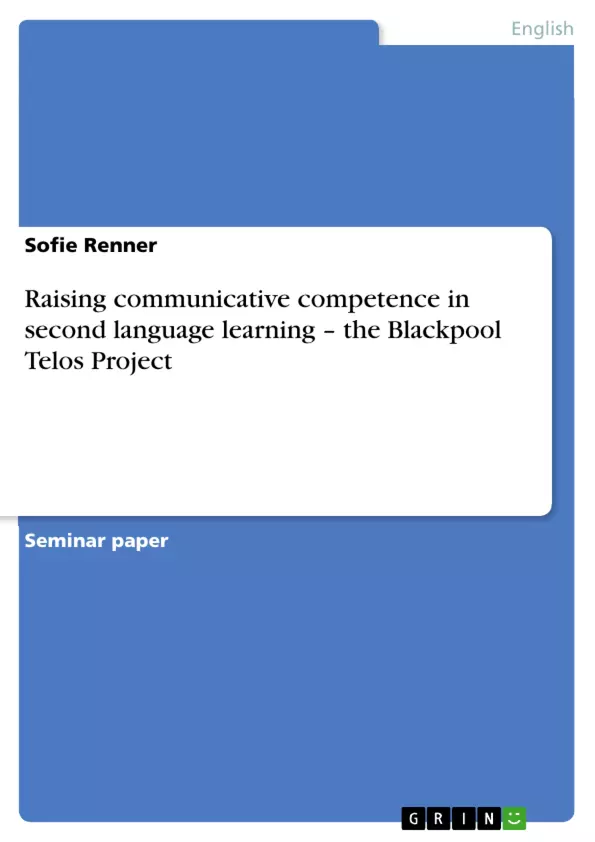“Communication is understood as the exchange and negotiation of information between at
least two individuals through the use of verbal and non-verbal symbols, oral and written/
visual modes, and production and comprehension processes” (Michael Canale 1983:4).
The aim of the Blackpool Telos Project is to raise communicative competence in second language learning of 10th and 11th grade german grammar school students. The BTP is also suitable for advanced adult learners. The above mentioned quotation should serve as a kind of guiding principle for the following analysis. One should bear in mind that according to Breen & Candlin (1980), Morrow (1977) and Widdowson (1978), communication is a form of social interaction and is unpredictable and creative both in form and message. Communication occurs in sociocultural contexts and in discourse, it is performed under limiting psychological and other conditions. It always has a purpose and involves authentic as opposed to textbook language. And finally, communication is considered to be successful or not on the basis of actual results.
The learner and his needs, the learning goal and the final realization within Telos are the most important points. In the BTP, special emphasis will be put on the independent learning of a second language in a constructive environment. Here, English is considered as a second language and not foreign language because it is used within the own language field. Non native English speakers can find themselves in two situations: “einerseits Situationen, in denen Englisch als ‘fremde Sprache’ verwendet wird, d.h. außerhalb des eigenen Sprachraums und der für die eigene Kultur und Gesellschaft alltäglichen Kommunikationsanlässe und –funktionen; andererseits Situationen, in denen dem Englischen innerhalb des eigenen Sprachraums als ‘zweite Sprache’ neben der eigentlichen Muttersprache eine kulturell und gesellschaftlich verankerte und bedeutsame Rolle zukommt” (Kohn, Kurt 2002: 1).
The organization of this paper is as follows. First I will provide a theoretical background for the BTP. Special emphasis is put on defining communicative approaches. The second part connects theory and practice. In this part, the main aim of the Blackpool Telos Project, and an introduction to the different activities, will be discussed and linked to constuctivist ideas. The third part will provide a linguistic context of the material and discuss the learning potential of the various tasks. In order to illustrate the third part, screenshots of the BTP will be used. The CD with the BTP will be attached to the paper.
Table of Contents
- 0. Introduction
- I. Main body...
- 1. Theoretical background
- Grammatical vs. communicative approaches
- Competence and performance
- Theories of basic communicative skills
- Communicative competence and actual communication
- Teaching and testing with focus on knowledge or skill
- Five elements for a communicative approach
- Constructivist learning
- 2. The Blackpool Telos Project in practice
- The aim of the Blackpool Telos Project...
- The idea of constructivist learning in connection with the BTP
- Activities and material analysis in the BTP
- Listening comprehension
- Description of the task
- Linguistic context of the listening comprehension
- Learning potencial
- Reading comprehension
- Description of the task
- Linguistic context of the reading comprehension
- Learning potencial
- Dialogue
- Description of the task
- Linguistic context of the dialogue task
- Learning potencial
- II. Conclusion
- III. Bibliography
Objectives and Key Themes
The Blackpool Telos Project aims to enhance communicative competence in second language learning for 10th and 11th grade German grammar school students. The project is also suitable for advanced adult learners. The study focuses on the theoretical background and practical implementation of the project, emphasizing the principles of constructivist learning and communicative approaches in language acquisition.
- The distinction between grammatical and communicative approaches in second language learning
- The concepts of competence and performance in language acquisition
- The application of constructivist learning principles in the Blackpool Telos Project
- The analysis of various tasks and materials used in the project to facilitate communicative competence
- The exploration of the learning potential of different activities within the project, such as listening comprehension, reading comprehension, and dialogue tasks
Chapter Summaries
The introduction defines the concept of communication and sets the stage for the analysis of the Blackpool Telos Project. It also introduces the project's objective of fostering communicative competence in second language learning. Chapter 1 delves into the theoretical foundation of the project, exploring the differences between grammatical and communicative approaches, discussing the concepts of competence and performance, and examining various theories of basic communicative skills. This chapter also emphasizes the importance of communicative competence in actual communication and explores different approaches to teaching and testing language skills. Chapter 2 focuses on the practical implementation of the Blackpool Telos Project. It highlights the project's aim, the use of constructivist learning principles, and provides an analysis of various activities, materials, and learning potential of each task.
Keywords
The main keywords and focus topics of the text are: communicative competence, second language learning, grammatical vs. communicative approaches, competence and performance, constructivist learning, Blackpool Telos Project, listening comprehension, reading comprehension, dialogue, language acquisition, task analysis, learning potential.
- Citar trabajo
- Sofie Renner (Autor), 2003, Raising communicative competence in second language learning – the Blackpool Telos Project , Múnich, GRIN Verlag, https://www.grin.com/document/92123



